What is a wart?The causes of the occurrence, diagnosis and methods of treatment will be analyzed in the article of a dermatologist with an experience of 37 years.
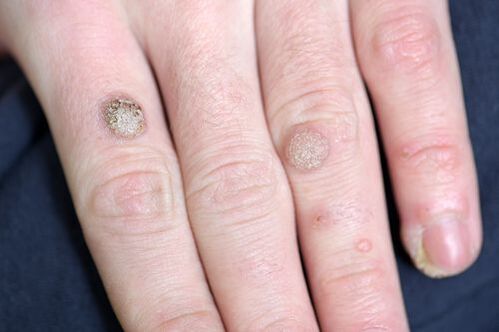
Determination of the disease.Causes of the disease
Warts-These are uneven light-bodily benign neoplasms of the skin in the form of localized growth of the upper layer of the skin (epidermis) with papules (nodules) or plaques.
The frequency of the appearance of warts in adults is 7-12 %, in school children-up to 10-20 %.
Warts are very similar to other skin neoplasms.Usually, a person cannot independently determine the disease independently, therefore, to make a diagnosis, it is necessary to contact a dermatologist.
The cause of the appearance of warts is the human papillomavirus.A variety of warts that can develop depends on the type of virus.So, each type of human papilloma virus affects the fabric on the localization that is most characteristic of it.
| Type of HPV | Extremely localization |
Types of warts |
|---|---|---|
| 1 | Feet, knees, palms, Brushes, fingers |
Subanary and palmar warts, Occasionally - simple warts |
| 2, 4 | Hands, fingers, knees, Less commonly - footsteps |
Simple warts, occasionally - plantar, palmar and mosaic warts |
| 3, 10 | Shin, hands, face | Flat warts |
| 7 | Brushes, fingers | Butcher warts |
| 5, 8, 9, 12, 14, 15, 17, 19-24 |
Face, hands, The front of the body |
Verruchymic epidermodysplasia |
Infection with a virus usually occurs in a contact path - with a direct contact of infected and healthy skin (for example, with handshake) or indirect (through handrails, toys, etc.).Therefore, it is possible to become infected with the human papillomavis virus in a wide variety of places - in public transport, at school, at work, houses, in places with high contact and humid environment (pools, saunas, gyms).Small injuries of the epidermis through which viruses, as well as inflammation of the skin fall, contribute to infection.
Also, the appearance of warts contribute to:
- immunodeficiency (including HIV infection);
- warm and humid environment;
- The need for professional contact with meat and fish ("butcher warts").
Some types of human papilloma virus are transmitted from parents.
But from toads and frogs, despite the horror stories that are so often scared in childhood, you can’t get infected - this is one of the most popular myths about this disease that has no reason.
If similar symptoms are detected, consult a doctor.Do not self -medicate - it is dangerous for your health!
Symptoms of warts
Depending on the type of wart, symptoms will vary.

Ordinary wart:
- Round dense papule of a conventional color with a size of 1-10 mm and larger.
- The surface of the papule is covered with cracks, layers.
- If the dad is on the finger, then the imprint disappears and distorts.The same applies to the drawing of the palm.
- Simple warts are located both single and several pieces - usually they appear in places of greatest injury (hands, fingers, knees).
- When examining with a dermatoscope, the doctor can see small brown points - thrombed (clogged) capillaries.Patients often call such points "roots".This is the main feature for the doctor: the dermatologist can distinguish a wart from other similar diseases (for example, contagious molluscus and keratomas).
Social (horn) wart:
- The main symptom due to which the patient usually consults a doctor is pain when pressing and walking.
- Such warts are localized usually on the feet.
- When contacting a doctor, as a rule, a keratinized uneven plaque of the usual color is visible, although at the first stage you can see an even smooth papule.With keratinization, the capillaries can be seen only if you remove the keratinized layer of the skin.
- The skin pattern is distorted.
- Typically, plantar warts are single, but there are 2-6 pieces;
- Often, these warts are confused with a corn (especially with dry) - with this description of the problem the problem, patients usually come to the reception.

Flat (youthful) wart:
- In appearance, this is a round, clear, smooth papule of normal, pink or brownish in color 1-5 mm.
- Appears on hands, lower legs, very often on the face.
- There are always several such warts - they are located in groups.
EpidermodisPlazia of verrucilia (senile wart):
- Large round numerous merging neoplasms of normal, pink or brown.
- Most often appear on the face, hands, front side of the body.
- You can confuse with keratoma, lichen and skin cancer.
Pathogenesis of warts
If the human papillomavirus enters the body in a latent state for a long time - a person usually does not even know about its existence.When factors appear favorable for the virus, it begins to "multiply" in the epithelium, leading to a change in tissues.
Unlike other viruses, the human papillomavirus does not destroy the cells of the epithelium - they die on their own, of course - in the process of keratinization and exfoliation.
The spread of infection is influenced by local factors and the state of the immune system.So, people with HIV infection or a transplanted kidney are more subject to the development of warts.Moreover, these neoplasms are often difficult to treat.With normal immunity, the virus does not affect the deeper layers of the skin, so many people have warts on their own after a few months.
The main stage in the appearance of warts is to accelerate the rate of division and cell growth with a virus.Such a quick metabolism leads to the thickening of skin layers.Since the fabrics grow in a certain, small area, a tubercle occurs, which is called a wart.
Classification and stages of wart development
There is no universally recognized classification of warts.However, several frequently encountered varieties can be distinguished:
- Ordinary wart- The most common type (70 % of warts are exactly them).Such neoplasms are not felt and cause only aesthetic discomfort to a person.
- Social wart- It appears on the feet, painful, therefore requires treatment.The occurrence of such a wart is facilitated by skin injuries due to uncomfortable, cramped, rubbing shoes.
- Flat warts- More often they appear in young people, adolescents.This is due to the unstable hormonal background of young people, which affects the whole body.Usually flat warts are almost invisible.
- Senile warts- Inherent for the elderly.Often appear on parts of the body, which is covered with clothes, but can meet on the face and hands.If there is no discomfort, it is not worth treating such warts-healing in the elderly can take place much slower, which is in young people, due to slow metabolism.
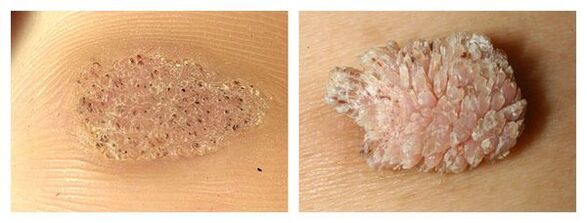
Other authors distinguish several more from these types of warts:
- Mosaic warts(HPV 2, 4) - neoplasms on the palms and soles.They look like foci of hyperkeratosis, that is, thickening of the stratum layer of the skin (usually in the front part of the foot), covered with deep cracks.
- Cystic warts(HPV 60) - a very rare type of neoplasm on the foot.It is a soft knot with cracks.When opening, white-yellow discharge appears, similar to cottage cheese.
- Film warts- Thin horn outgrowths near the mouth, nose or eyes.
- Warts "Butchers"(HPV 7) - appear on the hands and fingers of people who are constantly in contact with meat and fish.They are presented in the form of hypertrophied neoplasms similar to cauliflower, but normal color.
In addition, the types of warts are distinguished depending on their localization.
Thus, an angental warts - tumor -shaped neoplasms that appear on the genitals (especially in places of skin transition to the mucous membrane) are often found.Usually they are caused by HPV 6 and 11.
Complications of wart
The main reason why patients with warts go to the doctor is an aesthetic defect that can affect the quality of the patient’s life, his self -confidence and develop a lot of complexes.Complications also include cracking of the surface of the wart and joining the infection, and with some types of warts - soreness during walking.
In malignant neoplasms, skin warts usually do not reborn, they are quite harmless, but in very rare cases, such a complication can still occur in people with oppressed immunity.
Other complications arise when trying to independently remove neoplasms.In this regard, inflammation and aesthetic defects in the form of scars may occur, as well as the further spread of the virus on the skin, which is why a person can wake up with several new ones in the morning after independent removal of one wart.
Remember that under the guise of warts a completely different disease can be hidden, which cannot be determined without consulting an experienced doctor.
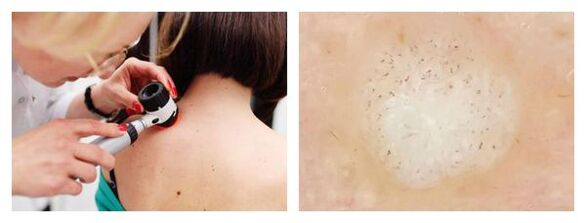
Diagnosis of wart
Typically, to make a diagnosis there is enough inspection (clinical picture) and a collected history (medical history).
To confirm the diagnosis, the doctor can conduct a histological study - the study of neoplasm cells.
It is very important to conduct differential diagnosis - to distinguish warts from other diseases.For example,Ordinary wartsIt is necessary to distinguish from the following diseases:
- Contagioine mollusk- More often appears on the body and genitals, less often on the hands and feet.It is a hemisphere with pressing on the surface, when pressed from the sides, the whitish "gruel" stands out.
- Epidermal warty nevus- More often solitary, a person has from birth.It rises above the surface of the skin, often covered with hair.
- Bazalioma- A tumor in the form of a roller of nodules, in the center is covered with a crust.Inherent for the elderly.
Ladomary-sustained wartsIt is necessary to distinguish from the following diseases:
- Keratoderma- Large areas of keratinization and inflammation of the skin.There are no shabby capillaries.
- Ladomary-sifilids- Multiple painless neoplasms, along the periphery, the skin is laying.The reaction to syphilis is positive.
- Corn- Usually painless, can cause pain only with vertical pressing.
The doctor should also differentiate the remaining types of warts from a number of diseases.In case of suspicion of another pathology, it can prescribe additional diagnostics (for example, the identification of antibodies for viruses, CT or MRI).
Treatment of warts
Treatment of warts is carried out for aesthetic purpose and to improve the quality of life of the patient.It can be prescribed only by a doctor after examination and an accurately diagnosis.Independent attempts to get rid of the wart are unacceptable, since the patient without medical education and the necessary equipment is not able to accurately determine the disease, and complications after such "treatment" occur much more often than recovery.
There are several methods of treatment for the treatment of warts.All of them are usually carried out under the supervision of a doctor, and some of them - only in the conditions of the procedural office of the clinic.
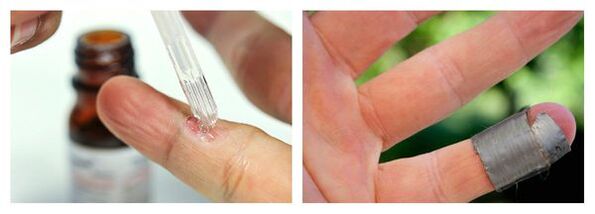
Chemical treatment methods
To get rid of the wart, applications of dairy-salicylic collidia and salicylic plasters are used.The percentage of drugs and the method of their use (long -term wearing of plasters, applications, etc.) depend on the prevalence and localization of the neoplasm.
Circus and 2-chlorpropionic acid solutions can also be used.In this case, the chemical composition is applied to the pre -processed surface, which is left on the wart until the color change (depending on the type of wart).The procedure is repeated several times after 7, 14 and 21 days.Before each procedure, the fabric is removed mechanically.
Another chemical method is a combination of nitrogen, acetic, oxalic, lactic acids and copper nitrate trihydrate.In this way, only relatively small neoplasms are treated - up to 5 mm.The solution is also left until the color of the wart is changed.After 3-5 days, the patient comes to the control technique, if necessary, he is prescribed a second procedure after 1-4 weeks.

Cryodestruction
This method consists in freezing the wart with liquid nitrogen: a moistened swab is pressed to damaged skin (with the capture of surrounding tissues in several mm) for 1-5 minutes.The destruction of some neoplasms requires several procedures with an interval of four weeks.
The main drawbacks of cryodestruction are its soreness and the defined effect in comparison with other methods in which only one procedure is often enough to remove.
Electrocoagulation
Under the influence of electric current, the wart is removed according to the layers.Such an operation is performed under local painkillers.
This method is more effective than cryodestruction, but it has a significant minus: electrocoagulation often leaves scars at the place of removal of the wart.For those patients who are addressed to eliminate a cosmetic defect,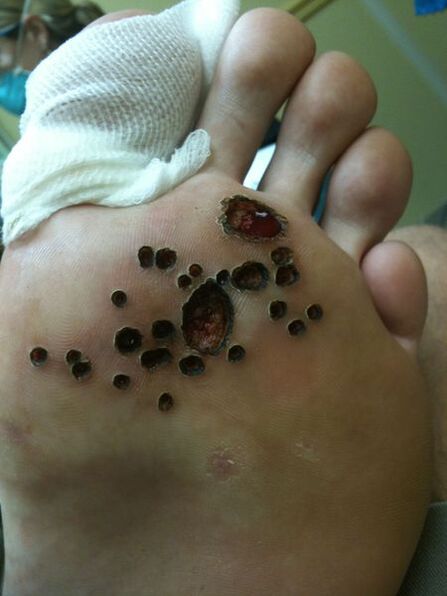 This method will not be the most suitable.
This method will not be the most suitable.
Laser destruction
With the help of a laser, warts are also removed in layers.The Svetoper is in contact with the skin from a few seconds to three minutes, depending on the size.Then the scab that appeared is excised, and the bottom of the wounds again treated with a laser.Then the patient is instructed about the methods of processing the wound.The operation itself is carried out under the influence of local anesthesia.
Radio wave surgery
Radio wave surgery is one of the most modern and gentle methods for removing some benign neoplasms, including warts.
The method is based on the generation of electromagnetic waves with different frequencies: from 100 kHz to 105 MHz.During the procedure, the tissues resist the passing waves, due to which molecular energy is released in the cells, which heats the skin.Under the influence of heat, the cells actually evaporate - a neat incision is obtained.At the same time, no mechanical effort is on the affected fabric.
Pros of this method:
- safety;
- rapid healing of the wound;
- good cosmetic effect - excluded scars and scars;
- Relative painlessness-a local analgesic is used before the mini-operation;
- Exclusion of secondary infection due to automatic disinfection of the electrode when the device is turned on.
The effectiveness of this method is recognized throughout the world, however, it is quite difficult to find a clinic in which the radio wave surgery method is used.
What is the treatment method to choose
All these methods have several disadvantages:
- In the first couple of weeks, the operated area has an unattractive appearance - crusts, darkening of fabrics.This must be taken into account if the warts are on visible parts of the body (for example, on the face).
- An unpleasant odor and some degree of pain during surgery.
In addition, each of these methods has contraindications that need to be found out on the preliminary consultation of a dermatologist.
But the main minus isHigh probability of relapse, especially if the warts were common, extensive.With each of these methods, doctors do not fight the root cause of the disease, but with its consequences, since todayThe human papilloma virus cannot be cured.
Therefore, therapy is directed:
- or the destruction of neoplasms arising at the site of the introduction of the virus;
- or to stimulate an antiviral immune response;
- or on the combination of these approaches.
Most often, destructive methods of treatment are used.Their effectiveness reaches 50-80 %.
For surgical methods of treatment, children's age is usually not a contraindication.Therefore, many of them (including radio wave surgery) are used to treat warts in children.An exception is chemical removal of warts due to the possibility of adverse reactions to the substance.
What to do after surgery
After any of these operations, be sure to follow the recommendations of the attending physician.
After removing the neoplasm of any of the methods presented, the doctor usually prescribes the processing of the removal place.It is forbidden to independently remove "crusts", wet the wound and expose it to direct sunlight.
If the patient is constantly suffering from warts, then he should consult a immunologist-it may require drug therapy, which will increase the resistance of immunity to manifestations of human papillomavirus.
Forecast.Prevention
If the patient does not have immunodeficiency, then warts can pass on their own, but this will need a lot of time - from several months to several years.So, in 65 % of cases, warts independently regress for two years.If two years later the wart is still on the spot, then it is recommended to remove it.Multiple neoplasms are recommended to be removed immediately.
With normal immunity and the correctly selected removal method (depending on the size and type of wart), it is possible to remove pathogenic tissue and achieve a good cosmetic effect.With reduced immunity and other predisposing factors, the human papilloma virus causes relapses.
Specific prevention of the disease does not exist.But is it so inevitable?
You can reduce the likelihood of a virus if you follow several rules:
- Do not go barefoot in public places where it is possible to injure the skin and become infected with a virus (pools, public showers, gyms).
- Choose high -quality shoes, change it more often.Try to make your legs dry.Heat and moisture are an excellent environment for the propagation of the human papilloma virus.
- To avoid patronage warts, go to manicure only to certified masters and make sure that they use sterile tools.
For the prevention of anogenital warts, according to WHO (World Health Organization), a four -glorious vaccine from the human papilloma virus is also highly effective.For the prevention of other types of warts, vaccines currently do not exist.
If you find one wart, then do not try to burn, cut it off on your own, cut it off - so you can contribute to the inflammation and further resettlement of the skin virus.After such a "removal" instead of one wart in the morning, you can wake up with ten.


















